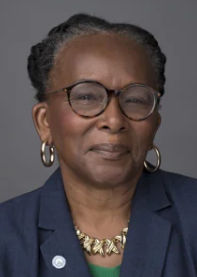Downtown ROCs: How a Grassroots Effort is Reimagining Rochester’s Urban Core
- George Cassidy Payne

- Jul 30
- 7 min read
Updated: Jul 30
This all started about six years ago, when Mike Gilbert moved into a downtown office overlooking a city park. “From my window, I could see the park wasn’t in great shape, broken benches and tables, concrete scattered across the lawn,” he recalls. “I realized this park was going to be kitty-corner from my office, and I thought: why not take the bull by the horns?”

For Gilbert, that moment was a catalyst. “Advocacy with the city can be powerful,” he says, “but there’s something special about rolling up your sleeves and doing your own part. I’ve always had a passion for downtown Rochester, and I knew we could do more.”
What began as a simple idea soon grew into an organization. Their next project was St. Joseph’s Park. “We started small, putting flower pots around trees, taking on little projects here and there. But it became clear we needed to structure this as a nonprofit.”

Thus, Downtown ROCs was born, a name that plays on words but also reflects their mission: to help downtown Rochester “rock” by transforming neglected spaces into places of beauty and connection.
“Year after year, we’ve been trying to scale up,” Gilbert explains. “We started small, but post-COVID, we’ve increased the amount of work we do: hauling away hundreds of pounds of litter, restoring and repainting city benches, benches that had good bones but just needed some care.”

They call their work placemaking. “It’s about finding forgotten spaces where just adding a bench or some flowers lifts the whole neighborhood,” Gilbert says. “It makes residents feel more invested in the city. People want to be out, to engage with each other.”
“When we first started out, we were a little rough around the edges,” Gilbert admits with a laugh. “We were just doing what we thought needed to be done, picking up trash, planting flowers, fixing what we could. But over time, we’ve built a fantastic relationship with the City’s Department of Environmental Services.”
That partnership has been key. “The City has been a real partner,” Gilbert says. “They often provide us with resources, like a dump truck full of mulch, rakes, even replacement street trees, sometimes just because we asked. They give us the tools we need and, in certain situations, free rein to improve public spaces that might not otherwise get attention.”
While some projects require permission, much of their work happens organically. “There are times when we check in with the City first, but often we just roll up our sleeves and get started. It’s a collaborative effort, the City is there when we need them, and together we’re able to make a bigger impact.”
“Our focus has always been on downtown,” Gilbert explains. “We’re not looking to expand into outlying neighborhoods, but we do get approached by groups from those areas, and we’re happy to partner when it makes sense, especially in fringe spaces around the Inner Loop and neighborhoods just beyond it. Often, we collaborate with other nonprofits, schools, or community groups on one-off, ad hoc projects. It’s all about working together to make an impact where it’s needed most.”

“We’re very grassroots and very small,” Gilbert says. “From the beginning, we’ve been fueled almost entirely by small individual donations—$25, $50, $100 at a time. That’s what has kept us going.”
Recently, though, Downtown ROCs has secured a few key grants that are helping the group grow. “We received a Neighbors in Action (NIA) grant—a modest amount, but it’s made a big difference,” he explains. “We also got a placemaking grant from ESL Federal Credit Union, which has allowed us to take on more ambitious projects.”
Looking ahead, Gilbert is hopeful about what’s next. “We want to quadruple our impact, the amount of work we can do, and keep finding ways to bring beauty and energy into downtown spaces.”
“I’ve been surprised, and really appreciative, of how responsive the City has been and how much they want to support us,” Gilbert says. “At first, I was a little skeptical about working with city government. But over time, I’ve seen how much they value what we’re doing. From a people standpoint, it’s been incredible to see how much they understand the importance of placemaking to the health of downtown.”
The community response has been just as inspiring. “It’s amazing how many people come up to us and say this is exactly how they’ve always felt, that downtown deserves this care and attention,” Gilbert shares. “It’s incredibly gratifying to hear that and to have our hard work validated in such a personal way.”
One of the most satisfying areas of their work has been at St. Joseph’s Park. “It’s both a structure and a park, the burned-out ruins of a church. The City owns the park, and the Landmark Society owns the building. We’ve positioned ourselves in the middle, working to beautify the space, activate it, and make it available to the public.”
For years, the park sat unused and closed off. “Now, we open it daily,” he says. “It’s become a serene oasis in the middle of downtown, a place many people didn’t even realize was there. Seeing folks walking around, enjoying their lunch, or just sitting quietly in this beautiful space has been incredibly rewarding.”
The team is also adding new elements to the park. “On Clinton and Pleasant, we’re creating a raised-bed community garden,” Gilbert shares. “Next week, we’re planting the garden, and in time, it will be dedicated in honor of Midge Thomas, who is turning 99.”
“The dream,” Gilbert says, “is that anyone could walk the entire city, from end to end, and have a pleasurable, enjoyable, safe, clean, and engaging experience. That’s the ultimate vision of urbanism: a city that’s truly walkable. When you create that, people want to live and work here. You get more people on the streets, more life in the spaces between buildings.”
For Gilbert, the future of downtown Rochester is about vibrancy. “I picture a downtown filled with children riding bikes, families walking and playing, a place that’s economically healthy, with grocery stores, corner shops, local businesses, and retail woven into the fabric of the city. It’s a vision of good urbanism: no dead zones, no surface parking lots creating gaps in the streetscape. Just energy and connection at every corner.”
“We know the history,” Gilbert says. “Redlining. Disinvestment. The way the Inner Loop divided neighborhoods. We can understand and acknowledge all of that, but we also have to move forward. Rochester has had a rough 40 or 50 years, but we’re poised for a rebirth.”
He’s careful not to romanticize the past. “The so-called ‘good old days’ weren’t necessarily all that good. There’s no reason Rochester can’t become a greater city, a model for what a mid-sized American city can be. A place with a high quality of life, walkable streets, and vibrant public spaces.”
Gilbert is aware of the challenges. “There are legitimate concerns, about education, about crime, but they’re not the end-all and be-all. We also have a lot of people stuck in nostalgia or acting as keyboard warriors, revising history instead of helping shape the future. But here’s the thing: we know what good urbanism looks like. We know what thoughtful economic development can bring. 2025 and beyond can be better than anything we’ve seen before, if we’re willing to work for it.”
“Gentrification is such a loaded word,” Gilbert acknowledges. “But let’s be clear, this isn’t Brooklyn. I’m of the opinion that a rising tide lifts all ships. We don’t need to push anyone down to lift a place up. We can have the best of both worlds: it’s aspirational. We can build nice housing, we can create beautiful spaces, and that helps everyone, people of all socioeconomic backgrounds.”
For Gilbert, the key is balance. “People want to live in a downtown where they can walk to grocery stores and local businesses. I consider downtown one big neighborhood, and I really resist the notion that investing in these spaces inevitably leads to a negative gentrification effect. If we increase the housing stock and create a mix of options, people of all means can live in the Center City. What we’re trying to do is create an environment where everyone feels welcome and invested in the future of downtown Rochester.”
“One of the things that frustrates me about Rochesterians,” Gilbert admits, “is this scarcity mindset, that it’s either-or. If I get something, someone else loses. We have to move beyond that. We can grow into a city that benefits everyone.”
For Gilbert, it comes down to creating a balanced urban ecosystem. “The quality of life indicators don’t lie—biking, walking, access to healthy food. Those things benefit everyone, regardless of income. And to make it work, you need all parts of the community: the wealthy, the working class, and everyone in between. It all supports the ecosystem of a thriving city. That’s the Rochester I believe in.”
“The one thing I want to say is this: we love what we do. It’s a passion for us,” Gilbert shares. “But really, everyone who cares about the city can do something. Everyone can pick up a piece of trash, pull a few weeds from a flowerpot on the street, or find the nearest overflowing garbage bin and take care of it. There are 10,000 people living downtown, if everyone did just one small act each day, imagine how much better our city could be.”
Let's ROC!
They are always interested in talking about downtown Rochester. If you have an idea for a collaboration, or would like to participate in a Downtown ROCs project,
Contact them at 585-370-5919















Comments